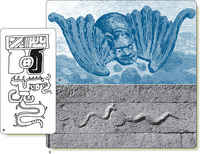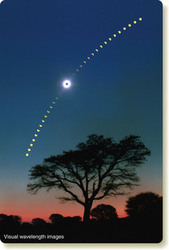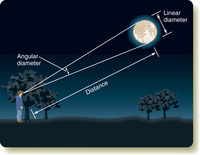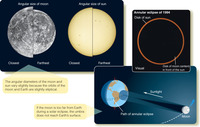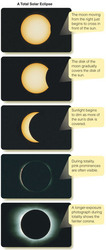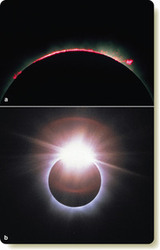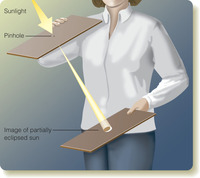|
|
FOR EONS, CULTURES WORLDWIDE HAVE UNDERSTOOD that the sun is the source of life, so you can imagine the panic people felt at the fearsome sight of the sun gradually disappearing in the middle of the day. Many imagined that the sun was being devoured by a monster (Figure 3-5). Modern scientists must use their imaginations to visualize how nature works, but with a key difference (How Do We Know? 3-1). You can take comfort that today’s astronomers explain solar eclipses without imagining celestial monsters.
A solar eclipse occurs when the moon moves between Earth and the sun. If the moon covers the disk of the sun completely, you see a spectacular total solar eclipse (Figure 3-6). If, from your location, the moon covers only part of the sun, you see a less dramatic partial solar eclipse. During a particular solar eclipse, people in one place on Earth may see a total eclipse, while people only a few hundred kilometers away see a partial eclipse.
The Angular Diameter of the Sun and MoonSolar eclipses are spectacular because Earth’s moon happens to have nearly the same angular diameter as the sun, so it can cover the sun almost exactly. You learned about the angular diameter of an object in Chapter 2; now you need to think carefully about how the size and distance of an object like the moon determine its angular diameter. This is the key to understanding solar eclipses.
Linear diameter is simply the distance between an object’s opposite sides. You use linear diameter when you order a 16-inch pizza—the pizza is 16 inches across. The linear diameter of the moon is 3476 km.
The angular diameter of an object is the angle formed by lines extending toward you from opposite sides of the object and meeting at your eye (Figure 3-7). Clearly, the farther away an object is, the smaller its angular diameter.
To find the angular diameter of the moon, you need the small-angle formula. It gives you a way to figure out the angular diameter of any object, whether it is a pizza, the moon, or a galaxy. In the small-angle formula, you should always express angular diameter in seconds of arc2 and always use the same units for distance and linear diameter:

You can use this formula to find any one of these three quantities if you know the other two; in this case, you are interested in finding the angular diameter of the moon.
The moon has a linear diameter of 3476 km and a distance from Earth of about 384,000 km. What is its angular diameter? The moon’s linear diameter and distance are both given in the same units, kilometers, so you can put them directly into the small-angle formula:

To solve for angular diameter, you can multiply both sides by 206,265 and find that the angular diameter is 1870 seconds of arc. If you divide by 60, you get 31 minutes of arc or, dividing by 60 again, about 0.5°. The moon’s orbit is slightly elliptical, so it can sometimes look a bit larger or smaller, but its angular diameter is always close to 0.5°. It is a Common Misconception that the moon is larger when it is on the horizon. Certainly the rising full moon looks big when you see it on the horizon, but that is an optical illusion. In reality, the moon is the same size on the horizon as when it is high overhead.
You can repeat this small-angle calculation for the angular diameter of the sun. The sun is 1.39 × 106 km in linear diameter and 1.50 × 108 km from Earth. If you put these numbers into the small-angle formula, you will discover that the sun has an angular diameter of 1900 seconds of arc, which is 32 minutes of arc or about 0.5°. Earth’s orbit is slightly elliptical, and consequently the sun can sometimes look slightly larger or smaller, but it, like the moon, is always close to 0.5° in angular diameter.
By fantastic good luck, you live on a planet with a moon that is almost exactly the same angular diameter as your sun. When the moon passes in front of the sun, it is almost exactly the right size to cover the brilliant surface of the sun.
The Moon’s ShadowTo see a solar eclipse, you have to be in the moon’s shadow. Like Earth’s shadow, the moon’s shadow consists of a central umbra of total shadow and a penumbra of partial shadow. What you see when the moon crosses in front of the sun depends on where you are in the moon’s shadow. The moon’s umbral shadow produces a spot of darkness roughly 269 km (167 mi) in diameter on Earth’s surface. (The exact size of the umbral shadow depends on the location of the moon in its elliptical orbit and the angle at which the shadow strikes Earth.) If you are in this spot of total shadow, the sun’s bright surface is completely covered, and you see a total solar eclipse. Total solar eclipses are rare as seen from any one place. If you stay in one city, you will see a total solar eclipse about once in 360 years. If you are just outside the umbral shadow but in the penumbra, you see part of the sun peeking around the moon, and you see a partial eclipse. A total solar eclipse and a partial solar eclipse can be the same event seen from slightly different locations on Earth. Of course, if you are outside the penumbra of the moon’s shadow, you see no eclipse at all.
Because of the orbital motion of the moon, its shadow sweeps across Earth at speeds of at least 1700 km/h (1060 mph) (Figure 3-8). To be sure of seeing a total solar eclipse, you must select an appropriate eclipse (Table 3-2), plan far in advance, travel to the right place on Earth, and place yourself in the path of totality, the path swept out by the umbral spot.
Sometimes when the moon crosses in front of the sun, its angular diameter is too small to fully cover the sun’s bright surface. That can happen because the orbit of the moon is slightly elliptical, and its distance from Earth varies. When the moon is at perigee, its closest point to Earth, the moon is almost 12 percent larger in angular diameter than when it is at apogee, its most distant point from Earth. Also, because Earth’s orbit around the sun is very slightly elliptical, the sun’s angular diameter can vary by a total of about 3.4 percent. If a solar eclipse occurs when the moon’s angular diameter is too small, you would see an annular eclipse, a solar eclipse in which a ring (or annulus) of light is visible around the disk of the moon (Figure 3-9). An annular eclipse swept across the United States on May 10, 1994.
Features of Solar EclipsesA solar eclipse begins when you first see the edge of the moon encroaching on the sun. This is the moment when the edge of the penumbra sweeps over your location.
During the partial phases of a solar eclipse, the moon gradually covers the bright disk of the sun (Figure 3-10). Totality begins as the last sliver of the sun’s bright surface disappears behind the moon. This is the moment when the edge of the umbra sweeps over your location. So long as any of the sun is visible, the countryside is bright; but, as the last of the sun disappears, dark falls in a few seconds. Automatic streetlights come on, car drivers switch on their headlights, and birds go to roost. The darkness of totality depends on a number of factors, including the weather at the observing site, but it is usually dark enough to make it difficult to read the settings on cameras.
The totally eclipsed sun is a spectacular sight. With the moon covering the bright surface of the sun, called the photosphere,3 you can see the sun’s faint outer atmosphere, the corona, glowing with a pale, white light so faint you can safely look at it directly. The corona is made of hot, low-density gas, which is given a wispy appearance by the solar magnetic field, as shown in the last frame of Figure 3-10. Also visible just above the photosphere is a thin layer of bright gas called the chromosphere. The chromosphere is often marked by eruptions on the solar surface called prominences (Figure 3-11a), which glow with a clear, pink color due to the high temperature of the gases involved. The small-angle formula reveals that a large prominence is about 3.5 times the diameter of Earth.
Totality cannot last longer than 7.5 minutes under any circumstances, and the average is only 2 to 3 minutes. Totality ends when the sun’s bright surface reappears at the trailing edge of the moon. Daylight returns quickly, and the corona and chromosphere vanish. This corresponds to the moment when the trailing edge of the moon’s umbra sweeps over the observer.
Just as totality begins or ends, a small part of the photosphere can peek out from behind the moon through a valley at the edge of the lunar disk. Although it is intensely bright, such a small part of the photosphere does not completely drown out the fainter corona, which forms a silvery ring of light with the brilliant spot of photosphere gleaming like a diamond (Figure 3-10b). This diamond ring effect is one of the most spectacular of astronomical sights, but it is not visible during every solar eclipse. Its occurrence depends on the exact orientation and motion of the moon.
Observing an EclipseNot too many years ago, astronomers traveled great distances to forbidding places to get their instruments into the path of totality and study the faint outer corona visible only during the few minutes of a total solar eclipse. Now many of those observations can be made every day by solar telescopes in space, but eclipse enthusiasts still journey to exotic places for the thrill of seeing a total solar eclipse.
During the partial phase, part of the sun remains visible, so it is hazardous to look at the eclipse without protection. Dense filters and exposed film do not necessarily provide protection, because some filters do not block the invisible heat radiation (infrared) that can burn the retina of your eyes. Problems like these have led officials to warn the public not to look at solar eclipses and have even frightened some people into locking themselves and their children into windowless rooms during eclipses. It is a Common Misconception that sunlight is somehow more dangerous during an eclipse. In fact, it is always dangerous to look at the sun, and the sun is even a bit less dangerous than usual during an eclipse because part of the brilliant surface is covered by the moon. The special danger posed by an eclipse is that people are tempted to ignore common sense and look at the sun directly, which can burn their eyes.
The safest and simplest way to observe the partial phases of a solar eclipse is to use pinhole projection. Poke a small pinhole in a sheet of cardboard. Hold the sheet with the hole in sunlight and allow light to pass through the hole and onto a second sheet of cardboard (Figure 3-12). On a day when there is no eclipse, the result is a small, round spot of light that is an image of the sun. During the partial phases of a solar eclipse, the image shows the dark silhouette of the moon obscuring part of the sun. These pinhole images of the partially eclipsed sun can also be seen in the shadows of trees as sunlight peeks through the tiny openings between the leaves and branches. This can produce an eerie effect just before totality as the remaining sliver of sun produces thin crescents of light on the ground under trees.
Of course, the first step to finding an eclipse to view is predicting when one will occur. Solar eclipses always occur at new moon, but most of the time, the new moon passes north or south of the sun, and there is no eclipse at all. Predicting which new moons can produce solar eclipses takes a bit of imagination.
If you were on Earth watching a total solar eclipse, what would astronauts on the moon see when they looked at Earth?
Building this argument requires that you change your point of view and imagine seeing the geometry from a new direction. Astronauts on the moon could see Earth only if they were on the side that faces Earth. Because solar eclipses always happen at new moon, the near side of the moon would be in darkness, and the far side of the moon would be in full sunlight. The astronauts would be standing in darkness, and they would be looking at the fully illuminated side of Earth. They would see Earth at full phase. The moon’s shadow would be crossing Earth; and, if the astronauts looked closely, they might be able to see the spot of darkness where the moon’s umbral shadow touched Earth. It would take hours for the shadow to cross Earth.
Standing on the moon and watching the moon’s umbral shadow sweep across Earth would be a cold, tedious assignment. Perhaps you can imagine a more interesting assignment for the astronauts. What would astronauts on the moon see while people on Earth were seeing a total lunar eclipse?
Figure 3-5
(a) A 12th-century Mayan symbol believed to represent a solar eclipse. The black-and-white sun symbol hangs from a rectangular sky symbol, and a voracious serpent approaches from below. (b) The Chinese representation of a solar eclipse shows a monster usually described as a dragon flying in front of the sun. (From the collection of Yerkes Observatory) (c) This wall carving from the ruins of a temple in Vijayanagara in southern India symbolizes a solar eclipse as two snakes approach the disk of the sun. (T. Scott Smith)
Figure 3-6
Solar eclipses are dramatic. In June 2001, an automatic camera in southern Africa snapped pictures every 5 minutes as the afternoon sun sank lower in the sky. From upper right to lower left, you can see the moon crossing the disk of the sun. A longer exposure was needed to record the total phase of the eclipse. (© 2001 F. Espenak, www.MrEclipse.com)
Figure 3-7
The angular diameter of an object is related to its linear diameter and also to its distance.
Figure 3-8
(a) The umbra of the moon’s shadow sweeps from west to east across Earth, and observers in the path of totality see a total solar eclipse. Those outside the umbra but inside the penumbra see a partial eclipse. (b) Eight photos made by a weather satellite have been combined to show the moon’s shadow moving across Mexico, Central America, and Brazil. (NASA GOES images courtesy of MrEclipse.com)
Figure 3-9
An annular eclipse occurs when the moon is far enough from Earth that its umbral shadow does not reach Earth’s surface. From Earth, you see an annular eclipse because the moon’s angular diameter is smaller than the angular diameter of the sun. In the photograph of the annular eclipse of 1994, the dark disk of the moon is almost exactly centered on the bright disk of the sun. (Daniel Good)
Figure 3-10
This sequence of photos shows the first half of a total solar eclipse. (Daniel Good)
Figure 3-11
(a) During a total solar eclipse, the moon covers the photosphere, and the ruby-red chromosphere and prominences are visible. Only the lower corona is visible in this image. (© 2005 Fred Espenak, www.MrEclipse.com) (b) The diamond ring effect can sometimes occur momentarily at the beginning or end of totality if a small segment of the photosphere peeks out through a valley at the edge of the lunar disk. (National Optical Astronomy Observatory)
Figure 3-12
A safe way to view the partial phases of a solar eclipse. Use a pinhole in a card to project an image of the sun on a second card. The greater the distance between the cards, the larger (and fainter) the image will be.
How Do We Know? 3-1
Scientific Imagination
Table 3-2
Total and Annular Eclipses of the Sun, 2008 to 2017

